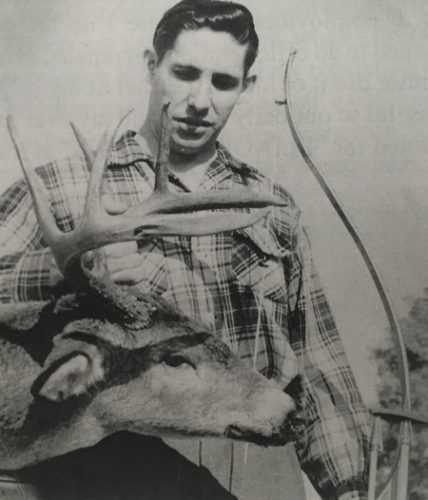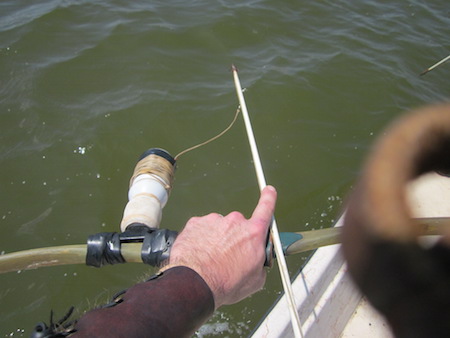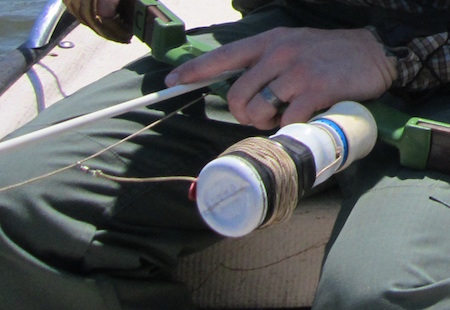https://tradbow.com/hunting-stingrays-learning-from-a-pioneer/
Hunting Stingrays; Learning From a Pioneer
The
small skiff motored ahead through an increasingly stiffening headwind
as the archers strained to see through the choppy surface and murky
depths. Suddenly, one of the bowmen shouted “RAY” and pointed starboard
with his arrow. Almost drawing simultaneously as the skiff turned
sharply toward the ray, two arrows cut the water just as a form the
width of the skiff itself jettisoned ahead. How did we miss?! This was
harder than it looked…

I was fortunate enough to befriend and learn the basics of stingray hunting from the late legendary bowfishing pioneer, and Maryland bowhunting legend, J. Rob Davis. Mr. Davis passed away in June of 2013, but his legacy is vast. He committed his life to promoting bowhunting, and especially to introducing new bowfisherman to the sport of stingray hunting. In 1952, Rob was instrumental in helping to lobby lawmakers to create the first bowhunting season in Maryland. During that short one-week season, Rob accounted for one of the first few deer taken in Maryland with the bow and arrow. His second deer took seven more years to collect, but that buck would turn out to be the first Maryland Pope and Young record book deer.
Over those years, bowfishing and mentoring others in this new sport became a passion for Rob that was fueled by the proximity of bays and coastal waterways around his home. He began to produce his own archery tackle, including constructing a small boat to help him pursue his quarry. Soon Rob became skilled at collecting carp and other rough fish, so he decided to turn his attention towards stingrays, and eventually even sharks. He collected his first ray in 1958. His largest ray weighed in at 133 pounds, but he often guided the boat while others shot larger specimens over 145 pounds. Some of the sharks he hunted or helped others shoot were over 8 feet long and over 200 pounds! Several hundred of his pupils from all around the country were tutored by this experienced instructor over the decades, and he penned over 100 articles for bowhunting publications. I was lucky enough to be among one of the last groups he was able to introduce to the sport.
At the time of our trip in 2012, described at the beginning of this story, Mr. Davis had over 60 years of bowfishing experience under his belt. In addition, the first mate on our trip was Rob’s son, adding another well-seasoned instructor to our experience. I will attempt to describe the techniques and equipment taught to us during this hunt.

First, of all let’s discuss equipment. On our hunt with Mr. Davis, I used a strap-on accessory bushing upon which I had screwed the rubber crutch tip to accept a plastic bottle. Mr. Davis already had rigs that consisted of; a crutch end cap, a small sports drink bottle filled with expansion foam, a 2 inch strip of rubber bicycle inner tube stretched over the bottle, a plastic clip that was nothing more than a piece of coffee can plastic secured with glue under the inner tube making a tab, and about 20 feet of 400# test braided line attached to a heavy duty swivel. The swivel served as a slide threaded through a cabled fiberglass fish arrow.
Line is connected to, and wound around, the bottle allowing the shooter to fire line directly from the bottle, which is then pulled off the crutch tip and acts as a float as the ray departs. The float can be retrieved and line wound around the bottle like a reel until the ray is close enough to the boat/surface for a second arrow to be shot into it, if necessary on a larger ray.

One of the most vital pieces of equipment in this type of hunt is a good pair of polarized sunglasses. Mr. Davis was of the opinion that brown tinted lenses were superior in locating rays. Polarized glasses cut down tremendously on the surface glare and give the bowman a chance to spot the rays before they scoot away.
This technique demands teamwork and fluid communication with the helmsman of the vessel. The shooters stand at the bow of the boat, while the helmsman steers at a slow troll until a ray is spotted by the shooters. The shooters point in the direction of the ray with the arrow so that the helmsman can steer to within 10 or 15 feet of the ray for a shot. Because of the water refraction, the point of aim should be at the bottom edge of the ray to stick it, otherwise a miss high will result. The deeper and farther away the ray, the smaller and greater the angle of refraction, which increases the difficulty.
Once a ray has been hit, never handle the line alone without the protection of a leather glove! The bigger rays may take three arrows to get up to the boat and gaffed. After gaffing, the ray should be pulled up so it’s tail is in the water but it’s head can be hit with a cudgel (mallet with a 1 inch screw protruding from the face works well) and struck between the eyes a few inches back.

Once the cudgel has been applied, heave the ray on board the boat and immediately cut the tail muscles on each side (Mr. Davis uses a machete). Then the barb can be cut away and placed inside of a soda bottle with a 50% bleach solution. Kept in this solution overnight, and then rinsed with cold water, the venomous grey mucus will be dissolved, leaving a bright white memento of your hunt.
We only had that one fleeting chance at one of the bigger Southern rays on our 2012 hunt, but we did get plenty of shooting at the smaller cow-nosed rays. The bowmen’s inexperience, combined with difficult weather conditions that day, left us with loads of fun and a hunger to return some day and accomplish the mission. Regretfully, it will be without our mentor. Perhaps this writing may help to share his knowledge and continue the legacy of introducing more folks to this challenging and rewarding sport.
If you are lucky enough to catch a ray or two, below are some of Mr. Davis’s preferred cooking methods:
Cut the skinned meat into 2-inch strips and marinade overnight in equal parts of cooking oil, concentrated frozen lemonade mix, and light soy sauce. Mr. Davis preferred to grill over coals, but oven broiling for fifteen minutes per side was another favored method. Others have commented favorably on the use of commercial marinades as well.
Cutting rays into 1-inch chunks and dipping into a milk/egg mixture before coating in Italian breadcrumbs and deep frying is also very tasty. Ray also works well if parboiled to an opaque consistency and added to casseroles, crab cake, or any other “crab” recipe.

I was fortunate enough to befriend and learn the basics of stingray hunting from the late legendary bowfishing pioneer, and Maryland bowhunting legend, J. Rob Davis. Mr. Davis passed away in June of 2013, but his legacy is vast. He committed his life to promoting bowhunting, and especially to introducing new bowfisherman to the sport of stingray hunting. In 1952, Rob was instrumental in helping to lobby lawmakers to create the first bowhunting season in Maryland. During that short one-week season, Rob accounted for one of the first few deer taken in Maryland with the bow and arrow. His second deer took seven more years to collect, but that buck would turn out to be the first Maryland Pope and Young record book deer.
Over those years, bowfishing and mentoring others in this new sport became a passion for Rob that was fueled by the proximity of bays and coastal waterways around his home. He began to produce his own archery tackle, including constructing a small boat to help him pursue his quarry. Soon Rob became skilled at collecting carp and other rough fish, so he decided to turn his attention towards stingrays, and eventually even sharks. He collected his first ray in 1958. His largest ray weighed in at 133 pounds, but he often guided the boat while others shot larger specimens over 145 pounds. Some of the sharks he hunted or helped others shoot were over 8 feet long and over 200 pounds! Several hundred of his pupils from all around the country were tutored by this experienced instructor over the decades, and he penned over 100 articles for bowhunting publications. I was lucky enough to be among one of the last groups he was able to introduce to the sport.
At the time of our trip in 2012, described at the beginning of this story, Mr. Davis had over 60 years of bowfishing experience under his belt. In addition, the first mate on our trip was Rob’s son, adding another well-seasoned instructor to our experience. I will attempt to describe the techniques and equipment taught to us during this hunt.

First, of all let’s discuss equipment. On our hunt with Mr. Davis, I used a strap-on accessory bushing upon which I had screwed the rubber crutch tip to accept a plastic bottle. Mr. Davis already had rigs that consisted of; a crutch end cap, a small sports drink bottle filled with expansion foam, a 2 inch strip of rubber bicycle inner tube stretched over the bottle, a plastic clip that was nothing more than a piece of coffee can plastic secured with glue under the inner tube making a tab, and about 20 feet of 400# test braided line attached to a heavy duty swivel. The swivel served as a slide threaded through a cabled fiberglass fish arrow.
Line is connected to, and wound around, the bottle allowing the shooter to fire line directly from the bottle, which is then pulled off the crutch tip and acts as a float as the ray departs. The float can be retrieved and line wound around the bottle like a reel until the ray is close enough to the boat/surface for a second arrow to be shot into it, if necessary on a larger ray.

One of the most vital pieces of equipment in this type of hunt is a good pair of polarized sunglasses. Mr. Davis was of the opinion that brown tinted lenses were superior in locating rays. Polarized glasses cut down tremendously on the surface glare and give the bowman a chance to spot the rays before they scoot away.
This technique demands teamwork and fluid communication with the helmsman of the vessel. The shooters stand at the bow of the boat, while the helmsman steers at a slow troll until a ray is spotted by the shooters. The shooters point in the direction of the ray with the arrow so that the helmsman can steer to within 10 or 15 feet of the ray for a shot. Because of the water refraction, the point of aim should be at the bottom edge of the ray to stick it, otherwise a miss high will result. The deeper and farther away the ray, the smaller and greater the angle of refraction, which increases the difficulty.
Once a ray has been hit, never handle the line alone without the protection of a leather glove! The bigger rays may take three arrows to get up to the boat and gaffed. After gaffing, the ray should be pulled up so it’s tail is in the water but it’s head can be hit with a cudgel (mallet with a 1 inch screw protruding from the face works well) and struck between the eyes a few inches back.

Once the cudgel has been applied, heave the ray on board the boat and immediately cut the tail muscles on each side (Mr. Davis uses a machete). Then the barb can be cut away and placed inside of a soda bottle with a 50% bleach solution. Kept in this solution overnight, and then rinsed with cold water, the venomous grey mucus will be dissolved, leaving a bright white memento of your hunt.
We only had that one fleeting chance at one of the bigger Southern rays on our 2012 hunt, but we did get plenty of shooting at the smaller cow-nosed rays. The bowmen’s inexperience, combined with difficult weather conditions that day, left us with loads of fun and a hunger to return some day and accomplish the mission. Regretfully, it will be without our mentor. Perhaps this writing may help to share his knowledge and continue the legacy of introducing more folks to this challenging and rewarding sport.
If you are lucky enough to catch a ray or two, below are some of Mr. Davis’s preferred cooking methods:
Cooking and Preparation:
First remove the skin of the “wings” before the underlying fillets are removed, otherwise removing the skin is difficult. Make sure ALL cartilage and the white membrane that separates the muscle from the internal organs are removed, otherwise the fillets will have an ammonia odor and taste. Both the top and bottom of the wings can be filleted in this manner.Cut the skinned meat into 2-inch strips and marinade overnight in equal parts of cooking oil, concentrated frozen lemonade mix, and light soy sauce. Mr. Davis preferred to grill over coals, but oven broiling for fifteen minutes per side was another favored method. Others have commented favorably on the use of commercial marinades as well.
Cutting rays into 1-inch chunks and dipping into a milk/egg mixture before coating in Italian breadcrumbs and deep frying is also very tasty. Ray also works well if parboiled to an opaque consistency and added to casseroles, crab cake, or any other “crab” recipe.

No comments:
Post a Comment